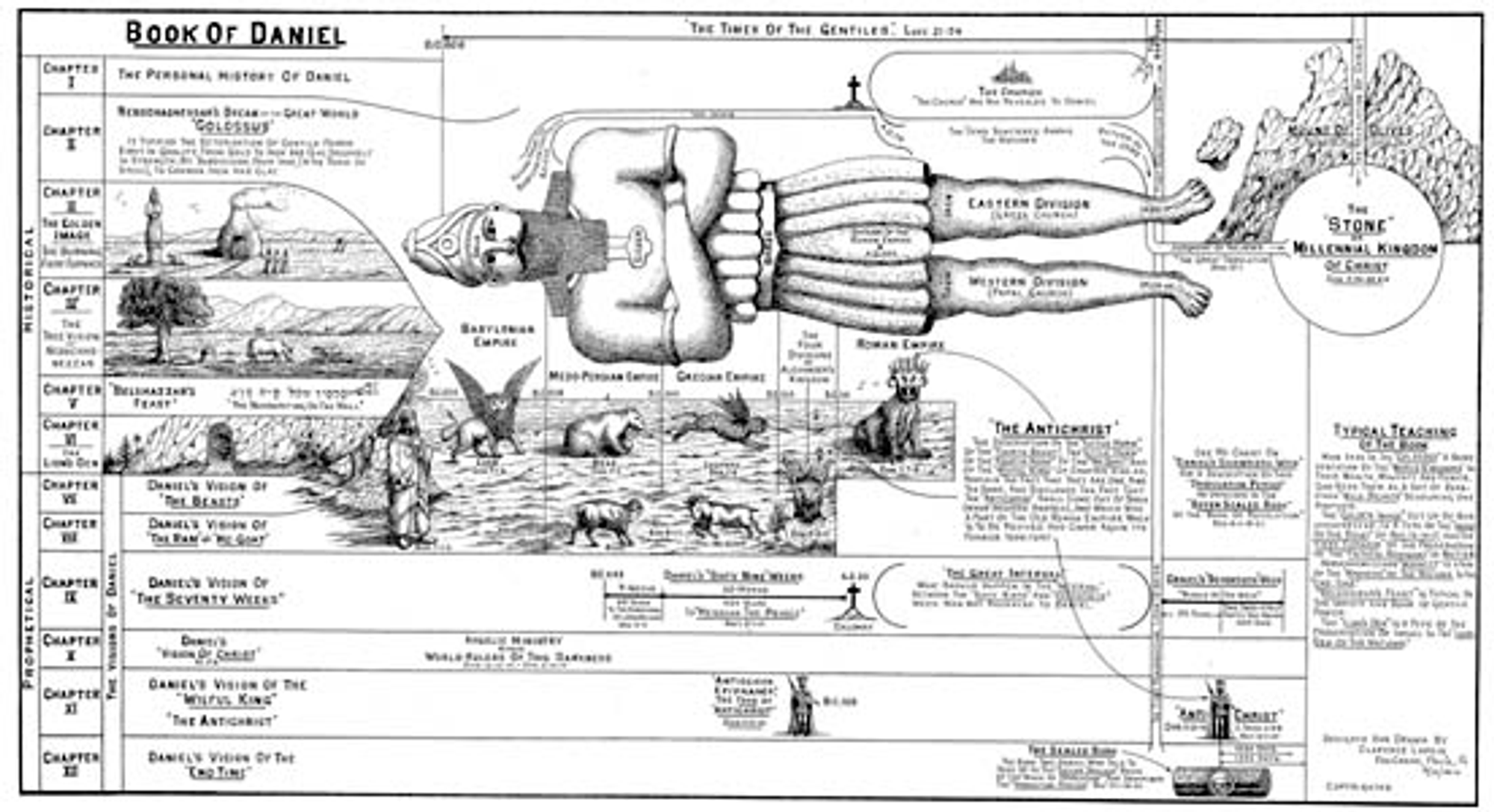The Groundbreaking Achievement of Clarence Larkin
Every now and then people come across a classic scholarly work that for one reason or another seems to have been forgotten or at least taken out of the main stream of cultural influence although their truth is just as timeless as when it was originally produced. Clarence Larkin’s book, Dispensational Truth, is one such treasure. It is still sold in Christian bookstores and has been referenced by popular authors like Tim LaHaye, but that’s about the extent of it. His charts are available within Sword Searcher, which has a good bio. You can also get the full text and images for free at www.preservedwords.com.
To give you an idea of his influence over time, consider this: every illustration I’ve ever seen describing the statue in the vision of Daniel 2:31-45 is a variation of Larkin’s original graphic.

I can identify with this particular author because, like me, he was a young mechanical engineer with some experience in drafting before being called into ministry. While a pastor, he employed his skills toward creating exacting illustrations of the Bible. The Larkin Estate indicates that he produced 205 charts and illustrations, complete with biblical references and full explanations of each. The ones I find most impressive are his works titled “Rightly Dividing the Word of Truth” and “The Book of Revelation.”
The original illustrations are a black-and-white copies of his hand-drawn charts and woodcuts. While Mr. Larkin did produce color charts, those he published were not, perhaps due to technology or cost limitations on producing a full-color book back in the 1920’s. I have found some colorized versions, but in my opinion they lack the original quality of his work. It has been on my to-do list for some time to make an attempt at converting at least one of these charts to a high-quality, interactive web presentation. Given the astounding detail of each chart, I’m not expecting to complete that task any time soon (any graphic designers out there looking for a project?).
He built these graphics at a time when no one had heard of the Bible being converted to a digital format. No one could yet dream of the complex visualizations made possible by advanced technology of the information age. I personally believe he was ahead of his time in creating ways to visualize related points in a unified whole that gives a consistent biblical picture.
Clarence Larkin gives due credit to the one who made such a work possible:
“With profound gratitude and thankfulness for the blessing of his Heavenly Father…in the hands of the Holy Spirit…”
Indeed, without the direction of the Spirit, no one man alone could accomplish this remarkable work. He also could not have done it if he had chosen to focus efforts on presenting and debating multiple theological views. On this point, the author states:
“[I have] sought to avoid such criticisms and to simply expound the Word of God as the Holy Spirit opened it up to [me.]”
It took three years to produce a book on just one theological view which he earnestly believed and was framed by nothing more or less than the scriptures. Had he gone beyond that into every wind of doctrine, three years would scarcely be enough to complete a discussion on the Book of Daniel alone!
Therein lies an area in which I believe it’s time to shift our thinking about the way we produce and use Bible study software. Everything available today includes a host of commentaries, versions, systematic theologies…all of which tend to have conflicting viewpoints to one degree or another. Yet, when Christians gather together for Bible study, only one such view is presented. To do otherwise would lead to confusion and be time prohibitive to boot. The same holds true for the working man or woman today who has trouble finding time to even read the Bible daily, let alone sift through a full library of data.
The teacher of such a study would wisely consult multiple resources while praying for God’s guidance, so in that sense today’s study tools are great. But, I believe that in-depth study should be made possible for everyone, not just the scholars and teachers. One way to do this is to 1) make it free to everyone and 2) limit the information to only authoritative works which agree with those of the author of said software as guided by the Spirit. While I do agree that it’s a not a good idea to limit access to multiple viewpoints, I do not think that presenting an endless list of options to sort through accomplishes that goal. That kind of information overload actually makes good information harder to find, which is the last thing I want.
By restricting the database to a more popular-level summary based on detailed and reliable scholarship of old (such as the charts mentioned above), I expect it to be possible for one or a few godly men to produce more advanced tools more economically. They could be used by anyone and would contain the same level of accuracy, detail, and cohesiveness of the many works of Clarence Larkin and others like him. Anyone willing to help in this endeavor is more than encouraged to pray and if you feel led to do so, contact me via email.
